Are you ready to discover the “10 Effective Exercises for Weight Loss” that can transform your fitness journey and help you to reach your weight loss goals? When it comes to weight loss, choosing the right exercises is the key. They are specifically selected for their ability to burn calories, boost metabolism, and support weight loss efforts. By including a variety of exercises in your workout routine, you can target different muscle groups, keep your workouts engaging, and maximize your results.
While exercise is important for weight loss, it is essential to maintain a balance approach. Along with regular physical activity, a healthy diet and lifestyle are also crucial factors in achieving sustainable weight loss. Therefore, throughout in this article, we will provide clear instructions, tips, and variations for each exercise. It is important to listen to your body, seek professional advice if necessary, and make adjustments based on your individual needs. Let’s dive in and explore the exercise that can propel you towards a healthier, fitter you.
#1 Jumping Jacks
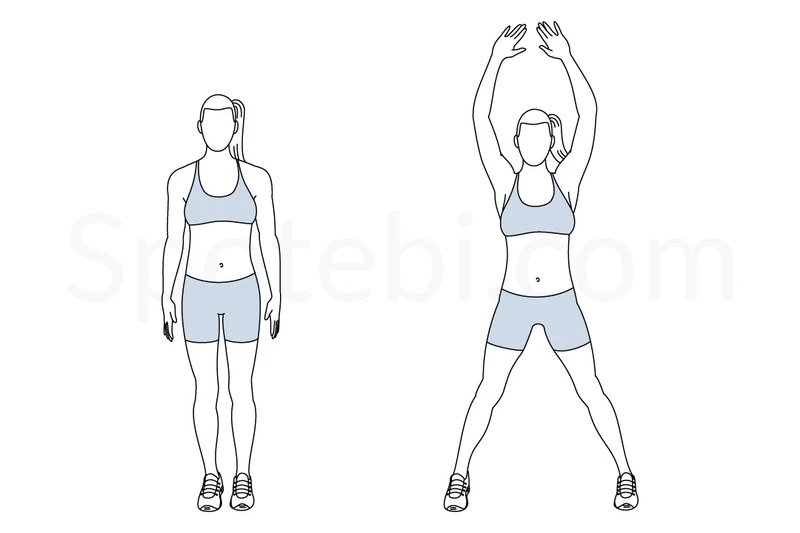
Jumping Jacks are a classic exercise that can be performed almost anywhere, making them a convenient choice for boosting your cardiovascular fitness and burning calories. To perform this exercise correctly, start by standing with your feet together and arms resting by your sides. Then jump your feet out wide while simultaneously raising your arms above your head. Next, quickly jump your feet back together while lowering your arms to the starting position. Repeat this movement in a fluid and controlled manner.
This exercise provides numerous benefits for your cardiovascular health. By engaging large muscle groups and increasing your heart rate, they help to improve your endurance and stamina. Additionally, this is an effective calorie-burning exercise, making them an excellent choice for weight loss.
If you are beginner or have some physical limitations, modifications can be made to suit your fitness level. For example, you can perform low-impact jumping jacks by stepping one foot out at a time instead of jumping. This reduces the impact on your joints while still proving a cardiovascular workout. As your fitness improves, you can gradually, increase the intensity by jumping higher and faster. Whether you do them as warm-up, a standalone exercise, or a part of a circuit, jumping jacks offer a versatile and accessible option for improving your cardiovascular fitness.
#2 High-Intensity Interval Training (HIIT)
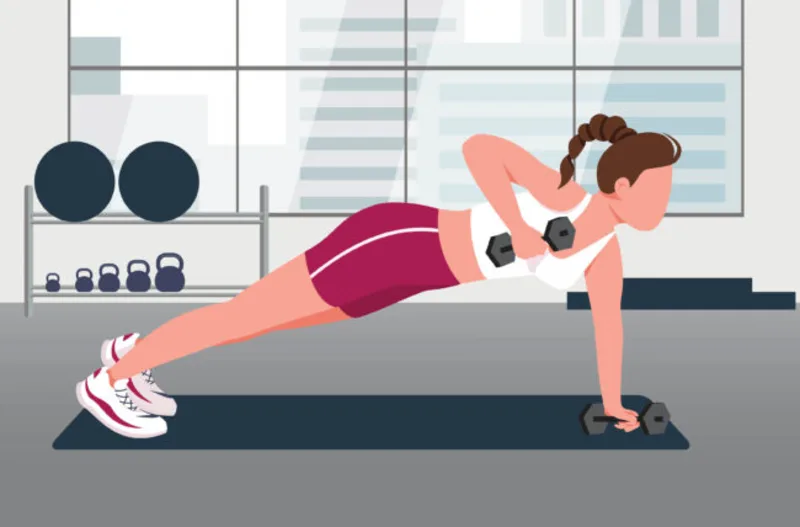
Generally, High-Intensity Interval Training (HIIT) is a workout technique that involves alternating periods of intense exercise with short recovery periods. HIIT is highly effective for weight loss due to its ability to maximize calorie burn and boost metabolism. During a HIIT workout, you perform short bursts of high-intensity exercises, such as burpees, mountain climbers, and squat jumps. These exercises engage multiple muscle groups and elevate your heart rate, leading to increased calorie expenditure. The explosive and dynamic nature of these exercises contributes to building strength, endurance, and cardiovascular fitness.
However, the key concept behind HIIT is intervals. Intervals refer to the alternating periods of high-intensity exercise and active recovery. For example, you might perform a high-intensity exercise, such as burpees, for 20 seconds, followed by a 10-second rest or low-intensity exercise like marching in place. This cycle is repeated for several rounds. The intensity levels during HIIT workouts can be adjusted to suit your fitness level. Therefore, beginners can start with shorter intervals or modify exercises to reduce impact. As you progress, you can increase the duration of high-intensity intervals or incorporate more challenging exercises.
Moreover, the beauty of HIIT lies in its efficiency. Due to the high-intensity nature of the exercises and the post-workout metabolic boost it provides, HIIT workouts can be shorter in duration, compared to traditional steady-state cardio workouts, while still delivering significant results.
Therefore, incorporating HIIT into your fitness routine offers a time-effective and effective approach to weight loss. By pushing your limits during intense intervals and allowing brief recovery periods, you can maximize calorie burn, enhance cardiovascular fitness, and achieve your weight loss goals efficiently than traditional exercises.
#3 Running Or Jogging
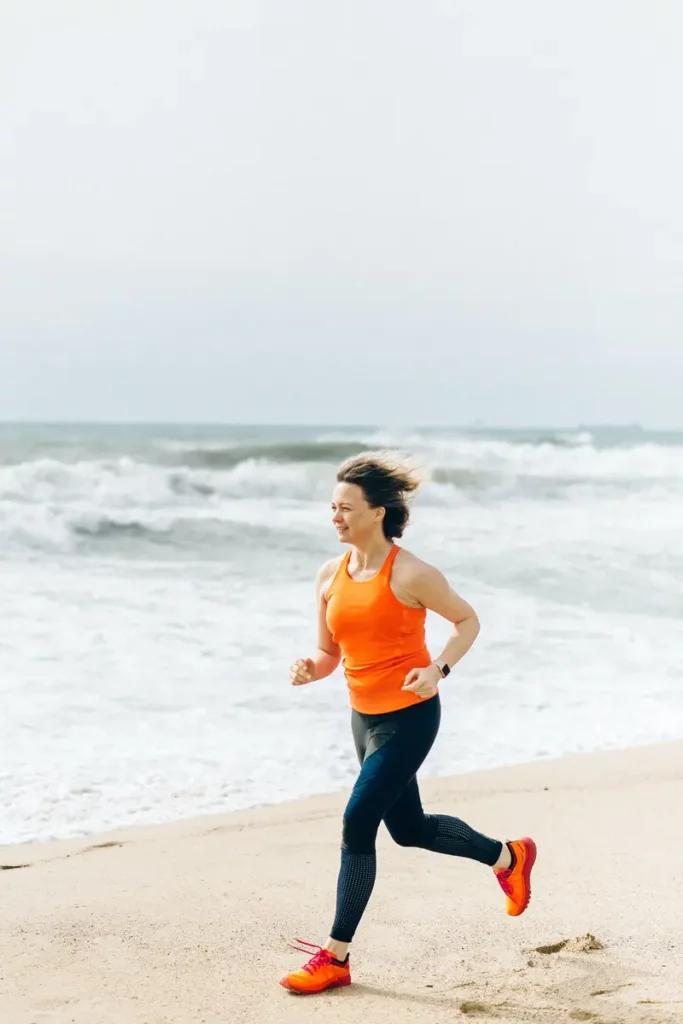
As we know, running or jogging is a simple and accessible form of exercise that can have a significant impact on your fitness and weight. Whether you prefer to run outdoors or on a treadmill, this activity offers numerous benefits for your overall health. One of the key advantages of running or jogging is its simplicity. All you need is a comfortable pair of shoes, and you are ready to go. You can run at your own pace, choose your preferred route, and enjoy the freedom of being outdoors or the convenience of an indoor treadmill.
In terms of weight loss, running or jogging is a highly effective calorie-burning exercise. It engages multiple muscle groups and elevates your heart rate, leading to increased energy expenditure. Regular running or jogging sessions can help create a calorie deficit, which is essential for shedding excess weight. Additionally, running or jogging offers excellent cardiovascular benefits. It strengthens your heart and lungs, improves circulation, and enhances your overall cardiovascular fitness. Regular aerobic exercise like running can also reduce the risk of various health conditions, such as heart disease and high blood pressure.
If you are a beginner, it is important to start slowly and gradually increase your running or jogging duration and intensity. Begin with a comfortable pace and distance that matches your current fitness level. Incorporate walking intervals if needed and gradually decrease the walking time as you build endurance. However, proper form and technique are crucial when running or jogging to avoid injuries. Maintain an upright posture, land softly on your midfoot, and swing your arms naturally. Invest in supportive running shoes that fit well to minimize the risk of discomfort or injury.
Remember to listen to your body and take rest days as needed to allow for recovery. As you become more comfortable with running or jogging, you can set goals to increase your distance, improve your speed, or participate in organized running events. By doing running or jogging, you can experience the physical and mental benefits of this straightforward yet effective exercise.
#4 Squats
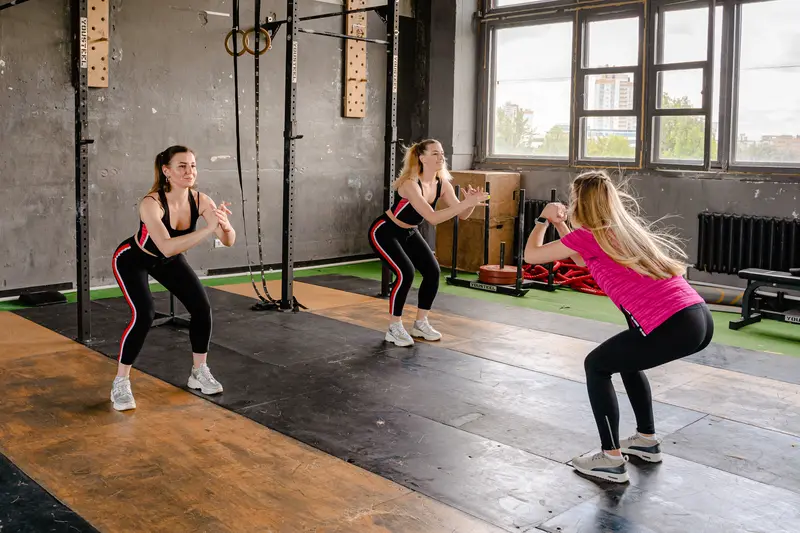
Generally, squats are a fundamental exercise that targets multiple muscle groups and offers a range of variations to suit different fitness levels. Mastering proper squatting technique can provide a myriad of benefits for your body.
To perform a squat correctly, start by standing with your feet shoulder-width apart. Lower your body by bending at the hips and knees, as if you are sitting back into an imaginary chair. Keep your chest up, back straight, and core engaged. Then, Lower until your thighs are parallel to the ground, then push through your heels to return to the starting position.
Bodyweight squats are an excellent option for beginners or those who are new to strength training. As you gain strength and confidence, you can progress to more challenging variations, such as goblet squats, where you hold a weight close to your chest while squatting. Squats primarily target the muscles of the lower body, including the quadriceps, hamstrings, glutes, and calves. Engaging these large muscle groups during squats can lead to increased muscle tone and strength. Furthermore, squats have a high metabolic impact, meaning they can elevate your calorie burn both during and after the exercise, supporting weight loss and improving overall metabolism.
Therefore, maintaining proper form and alignment is crucial during squats to maximize effectiveness and minimize the risk of injury. Keep your knees aligned with your toes, and avoid letting them cave inward. Ensure your weight is distributed evenly through your feet, and avoid rounding your back or leaning too far forward. If it is needed, practice squats in front of a mirror or seek guidance from a fitness professional to ensure proper form. By incorporating squats into your workout routine can provide a solid foundation for building lower body strength and improving overall functional fitness. As you progress, you can increase resistance by adding weights or trying more advanced variations. Remember to start with a weight or difficulty level that challenges you without compromising proper form.
#5 Push-ups
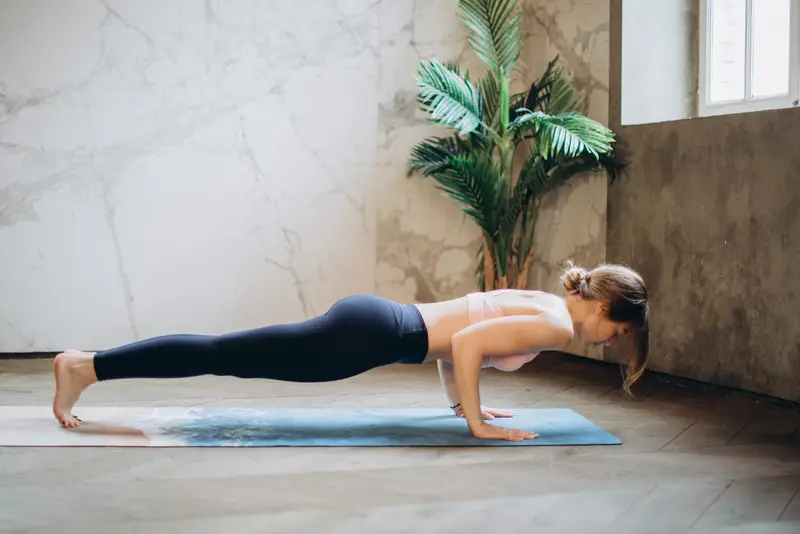
Normally, push-ups are a classic and effective exercise that targets multiple muscle groups and can be modified to suit different fitness levels. Understanding the correct form and variations of push-ups can help you maximize the benefits of this compound exercise.
To perform a push-up correctly, start in a high plank position with your hands slightly wider than shoulder-width apart and your body in a straight line from head to heels. Lower your body by bending your elbows, keeping them close to your sides, until your chest hovers just above the ground. Push through your palms to extend your arms and return to the starting position.
This exercise primarily works the muscles of the upper body, including the chest, shoulders, and triceps. As you lower your body, your chest muscles engage, while your shoulder muscles and triceps assist in the movement. Push-ups also engage your core muscles, providing additional stability and strengthening benefits. If you are a beginner or find standard push-ups challenging, modifications can be made. One option is to perform push-ups on your knees instead of your toes, which reduces the intensity. Alternatively, you can use an elevated surface, such as a bench or countertop, to decrease the amount of bodyweight you are pushing. These modifications allow you to build strength and gradually progress to full push-ups.
As you become more proficient in push-ups, there are several ways to make them more challenging. You can try wide-grip push-ups, diamond push-ups, or decline push-ups to target different muscle groups and increase the difficulty level. Additionally, incorporating variations such as plyometric push-ups or adding weights can further enhance strength and power. This exercise helps to develop upper body strength, improve muscular endurance, and enhance overall functional fitness. Remember to maintain proper form throughout the exercise, engage your core, and breathe rhythmically. With consistency and progression, push-ups can become a cornerstone of your fitness journey, helping you achieve a stronger and more toned upper body.
#6 Lunges

Lunges are a versatile lower body exercise that can be performed in various ways to target different muscle groups and enhance lower body strength. By incorporating lunge variations into your workout routine can offer numerous benefits for your legs, glutes, and overall lower body fitness.
There are several lunge variations to choose from, including walking lunges and reverse lunges. Walking lunges involve stepping forward with one leg, lowering your body until both knees are at 90-degree angles, and then stepping forward with the other leg. Reverse lunges, on the other hand, involve stepping backward instead of forward. These variations provide a dynamic and challenging workout for your quadriceps, hamstrings, glutes, and calf muscles. However, Lunges are highly effective for developing lower body strength and stability. They engage multiple muscle groups simultaneously, helping to improve muscle tone and increase overall lower body strength. Lunges also activate your core muscles, contributing to improved balance and functional fitness.
To maintain balance and proper alignment during lunges, it is important to keep a few key points in mind. First, keep your upper body upright and your chest lifted. Engage your core muscles to support your posture. Second, ensure that your front knee stays directly above your ankle as you lower your body. Avoid letting your knee extend beyond your toes to prevent unnecessary strain. Lastly, maintain a controlled and steady pace throughout the exercise, focusing on maintaining stability and proper form.
If you are new to lunges or have specific fitness needs, modifications can be made. You can start with stationary lunges before progressing to more dynamic variations. Additionally, using support, such as holding onto a chair or wall, can help with balance and stability. As you become more comfortable and stronger, you can increase the difficulty by adding weights or incorporating jumping lunges for a cardiovascular challenge. Hence, by performing lunges correctly and with proper alignment, you can maximize their effectiveness and minimize the risk of injury.
#7 Cycling
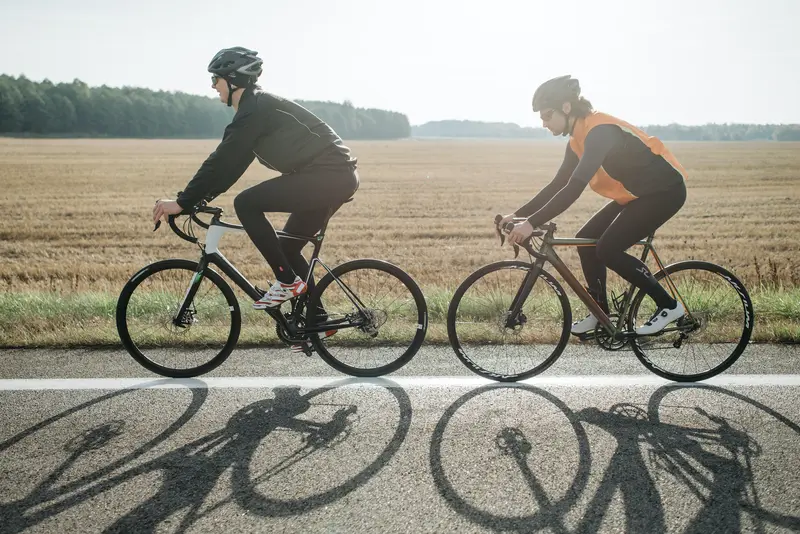
Normally, cycling is a fantastic exercise that offers numerous benefits for weight loss and cardiovascular health. Whether you prefer indoor cycling on a stationary bike or outdoor cycling, this activity provides an enjoyable and effective way to get moving and improve your fitness.
Cycling is a great option for weight loss as it is a low-impact exercise that can burn a significant amount of calories. It engages large muscle groups, such as the legs, glutes, and core, which increases your energy expenditure and helps shed unwanted pounds. Additionally, cycling is an excellent cardiovascular exercise that improves heart health, boosts endurance, and strengthens your lungs.
Indoor cycling, using a stationary bike, provides a convenient option for those who prefer to exercise at home or in a gym setting. It allows you to control the intensity, resistance, and duration of your workouts. Many stationary bikes also offer interactive features and programs that make the experience engaging and motivating. Outdoor cycling, on the other hand, offers the opportunity to enjoy fresh air, scenic routes, and a change of scenery. It can be a social activity, allowing you to cycle with friends or join cycling groups in your community. Outdoor cycling also adds an element of variability to your workouts, as you can tackle different terrains and experience the thrill of exploring new routes.
However, safety is paramount when cycling, especially for beginners. It is important to wear a properly fitting helmet to protect your head in case of a fall or accident. Obey traffic rules, signal your intentions, and stay visible to motorists by wearing bright clothing and using reflectors or lights. If cycling outdoors, choose safe routes with designated bike lanes or paths. For beginners, start with shorter rides or sessions on a stationary bike and gradually increase the duration and intensity as your fitness level improves. Focus on maintaining a comfortable pedaling cadence and proper form, keeping your back straight, and avoiding excessive strain on your knees.
#8 The Plank
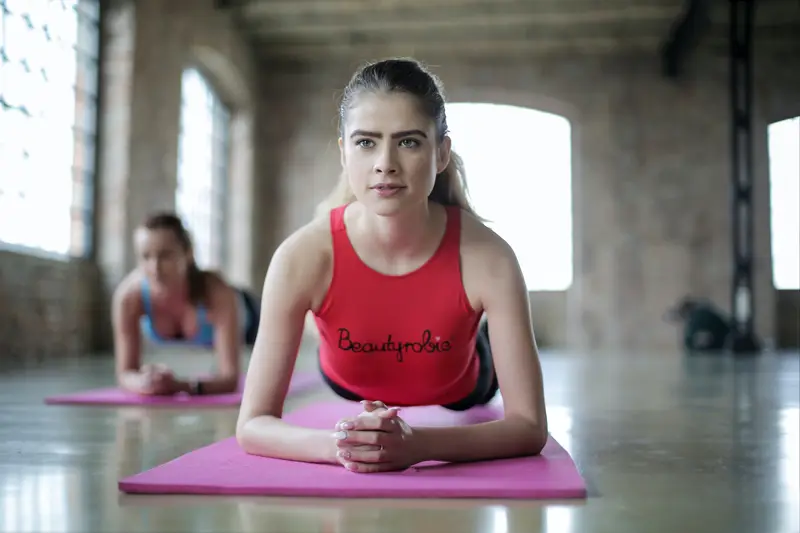
The plank is a highly effective exercise that targets your core muscles and helps improve overall stability. It is a simple yet challenging exercise that can be performed in various ways to continually challenge your body.
To perform a plank, start by assuming a push-up position, with your hands directly beneath your shoulders and your body in a straight line from head to heels. Engage your core muscles and hold this position for as long as you can while maintaining proper form and alignment.
There are different variations of the plank that target specific areas and add variety to your routine. The forearm plank is a popular variation where you rest on your forearms instead of your hands. This variation shifts the focus to your core and reduces strain on your wrists. Another variation is the side plank, which targets the obliques and improves lateral core strength. In a side plank, you balance on one forearm and the side of your foot, keeping your body straight and engaging your core muscles.
Generally, planks are excellent for strengthening your core muscles, including the abdominals, back muscles, and deep stabilizing muscles. By consistently performing planks, you can improve your posture, stability, and overall functional fitness. Strong core muscles also contribute to better balance and can help prevent injuries in other activities. If you are new to planks, it is important to start with a duration that challenges you without compromising proper form. Begin with holding the plank for 20-30 seconds and gradually increase the time as your strength and endurance improve. Remember to focus on maintaining a straight line from head to heels, avoiding sagging or lifting your hips.
To progress in your plank practice, you can gradually increase the duration or add variations. For example, you can try lifting one leg off the ground while maintaining the plank position or try performing plank exercises on an unstable surface like a balance board or exercise ball. Consistency is key when it comes to planks. Aim to include them in your regular workout routine, and gradually increase the intensity and difficulty to continue challenging your core muscles.
#9 Swimming

Usually, swimming is a wonderful exercise that offers a full-body workout while being gentle on the joints. It provides a unique combination of cardiovascular conditioning and muscle strengthening, making it an excellent choice for people of all fitness levels. One of the standout benefits of swimming is that it engages the entire body. As you move through the water, various muscle groups, including the arms, legs, core, and back, work in unison to propel you forward. This holistic approach to fitness makes swimming a highly effective exercise for building strength, endurance, and flexibility.
There are several swimming strokes to choose from, each with its own characteristics and calorie-burning potential. The freestyle stroke, also known as front crawl, is the most common and efficient stroke for swimming laps. It engages the muscles of the arms, shoulders, and core, while also providing an excellent cardiovascular workout.
Other popular swimming strokes include the breaststroke, backstroke, and butterfly. These strokes work different muscle groups and offer variety to your swimming routine. The breaststroke emphasizes the chest, shoulders, and inner thighs, while the backstroke targets the back muscles and improves posture. The butterfly stroke is a more advanced stroke that engages the entire body, particularly the core and upper body muscles.
For beginners, swimming is a low-impact activity that offers a gentle way to start an exercise routine. Start by focusing on basic techniques and gradually build your endurance. Consider taking swimming lessons or seeking guidance from a swim coach to learn proper form and breathing techniques. Paying attention to your body position, rhythm, and breathing will help you maximize the benefits of swimming while minimizing the risk of injury.
Further, swimming can be enjoyed in various settings, such as pools, lakes, or the ocean. If you are new to swimming, start in a controlled environment like a pool with a lifeguard on duty. Additionally, make sure to follow safety guidelines, such as swimming in designated areas and being aware of your surroundings. Enjoy the feeling of weightlessness in the water while reaping the benefits of improved cardiovascular health, increased muscle tone, and enhanced overall fitness.
#10 Jump Rope
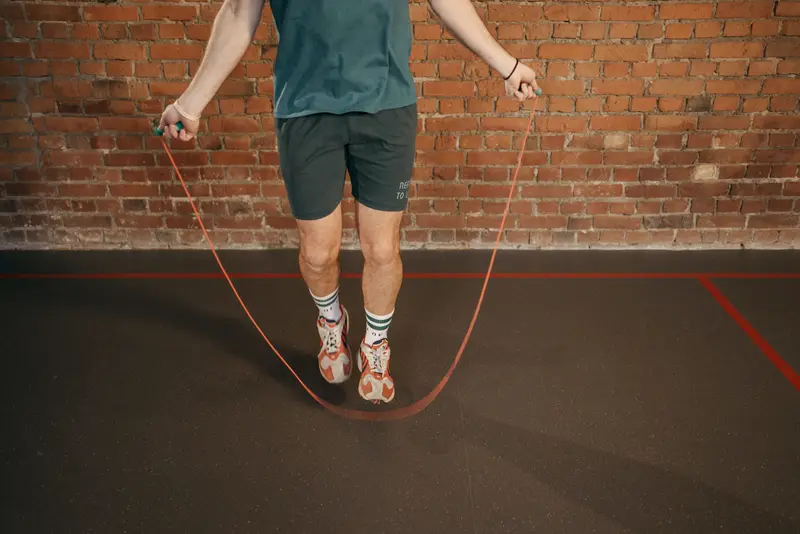
Jump rope is a simple yet highly effective exercise that can help you burn calories, improve cardiovascular fitness, and have fun at the same time. Learning the proper technique and incorporating jump rope into your fitness routine can offer a host of benefits for weight loss and overall fitness.
To jump rope correctly, start by selecting a rope that is the right length for your height. Hold the handles firmly and stand with your feet shoulder-width apart. Swing the rope over your head and jump off the ground as it approaches your feet. Land softly on the balls of your feet and maintain a steady rhythm as you continue jumping. This is a fantastic way to shed unwanted pounds and promote weight loss. It is a high-intensity cardiovascular exercise that engages multiple muscle groups, including your legs, arms, and core. By elevating your heart rate and increasing your metabolism, jump rope can help you burn a significant number of calories in a short amount of time.
Apart from weight loss, jump rope offers numerous cardiovascular benefits. Regular skipping sessions can improve your endurance, strengthen your heart and lungs, and enhance overall cardiovascular health. It is a convenient and efficient way to get your heart pumping and boost your aerobic capacity. As you become more comfortable with the basic jump rope technique, you can explore variations and different skipping techniques to add variety and intensity to your workouts. One popular technique is double unders, where the rope passes under your feet twice with each jump. However, this requires timing, coordination, and increased speed, providing an extra challenge and further elevating your heart rate.
Remember to start slowly and gradually increase the intensity and duration of your jump rope sessions. Focus on maintaining proper form, keeping your core engaged, and landing softly to minimize the impact on your joints. As with any exercise, listen to your body, and take breaks when needed. This is a portable and versatile exercise that can be done almost anywhere, making it a convenient option for incorporating cardio into your daily routine.
The Summery Of 10 Effective Exercises For Weight Loss
Incorporating these 10 exercises into your fitness routine can be a game-changer when it comes to weight loss and overall fitness. Each exercise targets different muscle groups and offers unique benefits, creating a well-rounded workout plan.
By engaging in exercises such as jumping jacks, high-intensity interval training (HIIT), running or jogging, squats, push-ups, lunges, cycling, planks, swimming, and jump rope, you can enjoy a variety of workout options that cater to your preferences and goals. However, before embarking on any new exercise regimen, it is crucial to consult with a fitness professional or healthcare provider. They can assess your individual needs, provide guidance on proper form and technique, and ensure that you’re engaging in exercises that are suitable for your current fitness level.
Remember, everyone’s fitness journey is unique, and what works for one person may not work for another. It is important to listen to your body, take it at your own pace, and gradually progress as you build strength and stamina. Therefore, if you are ready to kick-start your weight loss journey, consider incorporating these effective exercises into your routine. Be consistent, stay motivated, and enjoy the process. Remember that small steps taken consistently can lead to significant results over time. Further, make sure to prioritize your safety and well-being throughout your fitness journey. Warm up before each workout, cool down afterward, and listen to your body’s signals. If you experience any pain or discomfort, adjust, or modify the exercises as needed.
Now is the time to take actions and embark on your weight loss journey. Commit to incorporating these exercises into your routine, seek professional guidance, and stay dedicated. With determination and perseverance, you can achieve your weight loss goals and improve your overall fitness.